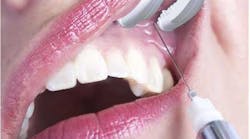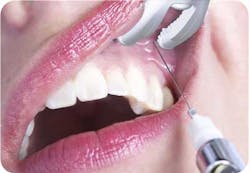New technologies, such as an innovative way to give dental injections, can help ease the pain for your patients.
The very thought of going to the dentist sends chills up the spine for many people.
According to recent studies at Columbia Dental School and the University of Washington, approximately 50% of the American population — 30 to 40 million people — avoid dental care as a direct result of anxiety and fear.
These statistics are compelling when you consider the consequences of pervasive dental neglect. Maintaining optimal oral health is essential to good overall health. Unfortunately, too many people fail to realize that their teeth and gums share tissue, nerves, and blood with other parts of the body. This tendency to think of the mouth as somehow self-contained leads many people to assign less significance to oral care than to other types of medical treatment.
Don’t be afraid of dental-phobic patients!
For dental-phobic patients, it is the perception of pain and discomfort that causes their fear. The truth is that dentistry today is not nearly as painful as it once was, and most patients now find the clinical experience to be more or less comfortable overall.
Most patients’ fear probably stems from an experience they had many years ago when dental procedures were indeed much more painful. Or, if not experienced firsthand, patients may base their perceptions on secondhand reports from parents, family, or friends. Popular media only exacerbates the problem, with the typical representation of dentists as “pain doctors” creating a rhetorical stigma around the profession that becomes difficult to break through.
Education is the key to combating odontophobia. As we learn new ways to make our practices less intimidating and market these evolved techniques to those who still associate dentists with discomfort and pain, we will successfully bring this fearful population into our offices for dental care and grow our practices.
The following is an overview of techniques dentists can adopt into practice to become a better fear-free clinician:
1. Offer pretreatment conditioning. Have your patients come in to the office for an initial meeting. Invite them to sit in the dental chair and spend a little time talking with your assistants and proving you are a patient clinician as you use this opportunity to get acquainted. You’ll be conditioning the patient to feel more comfortable in the dental chair rather than associating it with pain or fear. These pretreatment appointments are great opportunities to review the patient’s medical history, take preop photos, and — if the patient is up to it — mold pretreatment preliminary impressions or even perform an oral cancer screening. You will help the patient be able to relax prior to the procedure and secure his or her trust in you as their dentist.
2. Allow your patients to maintain control during treatment. Establish a fail-safe signal with your patients. For example, if they feel pain during a procedure, they can signal to you and you will stop what you are doing; this can be like a shut-off valve or circuit breaker. The signal can be as simple as raising a hand.
3. Use distraction techniques. Playing music during a dental procedure, especially with headphones, can really help to relax phobic patients. The music will distract them from the noises associated with the procedure. Recommend that patients bring a new CD or MP3 playlist so that the songs are different and interesting. Familiar music can too easily go unnoticed.
4. Stress professionalism. Remind the phobic patient that you see thousands of patients, including all kinds of different people and dental conditions every single day. The more patients are aware of the professional nature of your approach toward their body, the less insecure they are and less likely to feel that you are judging them.
5. Employ new dental innovations in your practice. New technological advances in the dental space, such as the DentalVibe Injection Comfort System, are used as an adjunct to the injection process, so dentists no longer have to “hurt” their patients in order to help them. This patented, award-winning instrument utilizes state-of-the-art VibraPulse technology to send soothing, pulsed, percussive vibrations deep into the oral mucosa simultaneously during the delivery of an injection. For more information go to www.dentalvibe.com.
6. Prescribe pharmacotherapy. Pharmaceuticals, including mild sedative agents, are also an option for promoting relaxation. These can be prescribed for the patient to take the night before a dental appointment to help them sleep, or on the day of treatment for the patient to be more comfortable coming into the office and sitting through the procedure.
Special considerations for pediatric patients:
7. Condition the child. Talk with parents about conditioning the child at home before coming in to the appointment. If the parents can practice placing fingers in the child’s mouth and brushing his or her teeth, the child will feel more comfortable with that experience during examination.
8. Remind parents not to project. Counsel parents not to project any of their own personal fears about the dentist onto their children. Young people should have the opportunity to experience modern-day dentistry for themselves ... and with all of the recent advancements in the dental health profession, their experience should only be a positive one.
As dentists, we are often so focused on our technical skills that we lose sight of one of the most important aspects of the practice of dentistry — the patient’s perspective. As patients become more aware of advances in pain-free dentistry, widespread odontophobia will begin to decline. Treating patients with the utmost concern for their fear, anxiety, and comfort will prove to be a win-win situation for both the patient and the dentist.
Enjoy our wonderful profession.








